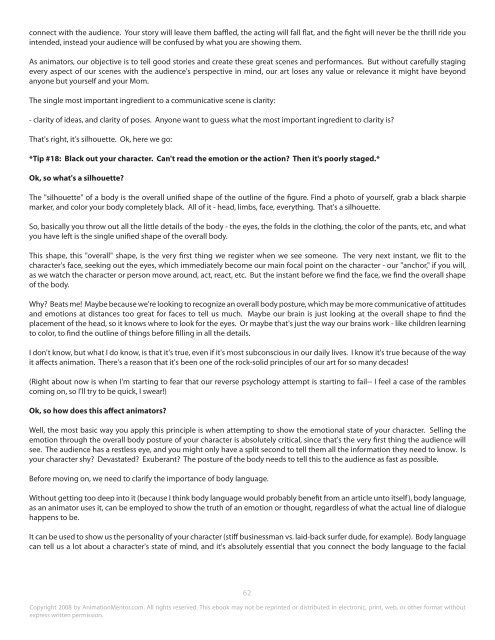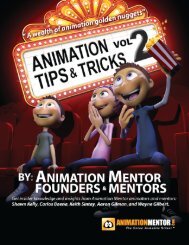BLACK OUT YOUR CHARACTEROk, so it's time for more animation rambling. Sometimes I start out acknowledging that I wrote WAY too much last time, and willendeavor to be more succinct this time out, but for some reason, those articles tend to be the longest of all -- so this time I'm goingtry some reverse psychology, and announce that this will be a really long article! The longest ever. You're going to be so sick ofanimation by the time you finish this article, that you'll unsubscribe from the <strong>Animation</strong> <strong>Mentor</strong> newsletter!(Ok, hopefully we've fooled it into letting this be a quickie. Cross your fingers!) And before we go any further, I just wanted to thankyou guys again for all the great questions and suggestions you've been emailing me. I love the feedback, and it's great to hear aboutwhat you're keen on us discussing next. Keep those mails comin’: tipsandtricks@animationmentor.com. (In fact, this week's topicwas requested by Anas Mohammad from Dubai, who asks about the importance of silhouette!)So, last week we dove into the concepts of twinning, as it applies to timing as well as posing. We talked about the robotic flavorinherent in all aspects of twinning, that twinning is the arch enemy of dynamic posing and believable performances, and we alsodiscussed how to not only recognize, but hopefully FIX your twinned scenes.This week, thanks to our friend Anas Mohammad, we're going to stick with the practical "nuts and bolts" stuff, and leap over to theconcept of silhouette.So, other than being a really difficult word to spell/type, what's this "silhouette" stuff?Well, what's your most important goal as an animator?Is it to make someone laugh? Is it to tell a good story? Is it to create a compelling acting performance that causes people to think?Is it to create a great fight sequence, or show your characters’ deepest emotions?Hopefully it's some or all of those things, and guess what? Every one of those can be summed up into one overall goal that you needto have as an animator: to communicate clearly with your audience.Your goal, in almost every scene you will ever touch, is clarity.If your goal is to make someone laugh, the staging of the setup and punchline of your joke had better be clear, or no one is goingto be laughing.Try telling a good story without clearly showing the major plot points, or a strong acting performance where you can't see yourcharacter's eyes or have a good view of the posture. Have a go at creating a dynamic fight scene where the punches are all stagedaway from camera so you can't see them thrown or whether they hit their target. You are going to find that your work simply doesn't61Copyright 2008 by <strong>Animation</strong><strong>Mentor</strong>.com. All rights reserved. This ebook may not be reprinted or distributed in electronic, print, web, or other format withoutexpress written permission.
connect with the audience. Your story will leave them baffled, the acting will fall flat, and the fight will never be the thrill ride youintended, instead your audience will be confused by what you are showing them.As animators, our objective is to tell good stories and create these great scenes and performances. But without carefully stagingevery aspect of our scenes with the audience's perspective in mind, our art loses any value or relevance it might have beyondanyone but yourself and your Mom.The single most important ingredient to a communicative scene is clarity:- clarity of ideas, and clarity of poses. Anyone want to guess what the most important ingredient to clarity is?That's right, it's silhouette. Ok, here we go:*Tip #18: Black out your character. Can't read the emotion or the action? Then it's poorly staged.*Ok, so what's a silhouette?The "silhouette" of a body is the overall unified shape of the outline of the figure. Find a photo of yourself, grab a black sharpiemarker, and color your body completely black. All of it - head, limbs, face, everything. That's a silhouette.So, basically you throw out all the little details of the body - the eyes, the folds in the clothing, the color of the pants, etc, and whatyou have left is the single unified shape of the overall body.This shape, this "overall" shape, is the very first thing we register when we see someone. The very next instant, we flit to thecharacter's face, seeking out the eyes, which immediately become our main focal point on the character - our "anchor," if you will,as we watch the character or person move around, act, react, etc. But the instant before we find the face, we find the overall shapeof the body.Why? Beats me! Maybe because we're looking to recognize an overall body posture, which may be more communicative of attitudesand emotions at distances too great for faces to tell us much. Maybe our brain is just looking at the overall shape to find theplacement of the head, so it knows where to look for the eyes. Or maybe that's just the way our brains work - like children learningto color, to find the outline of things before filling in all the details.I don't know, but what I do know, is that it's true, even if it's most subconscious in our daily lives. I know it's true because of the wayit affects animation. There's a reason that it's been one of the rock-solid principles of our art for so many decades!(Right about now is when I'm starting to fear that our reverse psychology attempt is starting to fail-- I feel a case of the ramblescoming on, so I'll try to be quick, I swear!)Ok, so how does this affect animators?Well, the most basic way you apply this principle is when attempting to show the emotional state of your character. Selling theemotion through the overall body posture of your character is absolutely critical, since that's the very first thing the audience willsee. The audience has a restless eye, and you might only have a split second to tell them all the information they need to know. Isyour character shy? Devastated? Exuberant? The posture of the body needs to tell this to the audience as fast as possible.Before moving on, we need to clarify the importance of body language.Without getting too deep into it (because I think body language would probably benefit from an article unto itself), body language,as an animator uses it, can be employed to show the truth of an emotion or thought, regardless of what the actual line of dialoguehappens to be.It can be used to show us the personality of your character (stiff businessman vs. laid-back surfer dude, for example). Body languagecan tell us a lot about a character's state of mind, and it's absolutely essential that you connect the body language to the facial62Copyright 2008 by <strong>Animation</strong><strong>Mentor</strong>.com. All rights reserved. This ebook may not be reprinted or distributed in electronic, print, web, or other format withoutexpress written permission.
- Page 2 and 3:
Animation Tips & TricksBY: Shawn Ke
- Page 4 and 5:
INTRODUCTIONWelcome to the First Ed
- Page 6 and 7:
FOUNDERS BIOSBobby BeckBobby was an
- Page 8 and 9:
TESTIMONIALS“Three things come to
- Page 10 and 11:
PLANNINGBecause this is the first a
- Page 12 and 13:
REFERENCE MATERIALSWe've been talki
- Page 14 and 15:
THUMBNAILSWelcome back!This month w
- Page 16 and 17:
BLINKS HAVE MEANINGTip 1: Blinks Ha
- Page 18 and 19:
Then a thought occurs to him: “is
- Page 20 and 21: has his shovel in hand. His eyes ar
- Page 22 and 23: THE FACEHey there animators! Welcom
- Page 24 and 25: OPERATIVE WORDSHello Animators!Welc
- Page 26 and 27: So, to make a long story short - ch
- Page 28 and 29: Well, for one thing, you want to sp
- Page 30 and 31: KEEP SECONDARY CHARACTERS SECONDARY
- Page 32 and 33: might glance at him to gauge his re
- Page 34 and 35: ACTINGHello Animators!Welcome back!
- Page 36 and 37: If you ignore the principles of act
- Page 38 and 39: Anyway, if the whole point of exagg
- Page 40 and 41: FORGET ABOUT THE LEGSHello animator
- Page 42 and 43: TRACK YOUR ARCSOkay, before I get s
- Page 44 and 45: it...Anyway, the hips move in a clo
- Page 46 and 47: TRACK YOUR ARCS - PART IIWell, gues
- Page 48 and 49: "Let's say my character is going to
- Page 50 and 51: But what's a love story without fir
- Page 52 and 53: cycle (say, a blink, or one hand ha
- Page 54 and 55: Step...Step...Punch. I had a big pr
- Page 56 and 57: after it. Once you choose your mome
- Page 58 and 59: incredibly easy to get so caught up
- Page 60 and 61: that's a toughie, but maybe you can
- Page 62 and 63: That's 40 years of inspiration. 40
- Page 64 and 65: TWINNINGHello!Last month, we were s
- Page 66 and 67: more organic, and far more interest
- Page 68 and 69: The end result, of course, is a far
- Page 72 and 73: performance (particularly the eye a
- Page 74 and 75: RISE ABOVE THE SNOBBERYOkay, here's
- Page 76 and 77: Animation students live and work in
- Page 78 and 79: MOVING FROM TRANFORMERS TO CARTOONS
- Page 80 and 81: stylistically. Too fast here, dead
- Page 82 and 83: HOW TO IMPRESS RECRUITERSHello ther
- Page 84 and 85: ecruiter has no idea of your true a
- Page 86 and 87: 23TIPREVERSALSWell hello there!Last
- Page 88 and 89: From #1 to #2, all you really need
- Page 90 and 91: else we can decide that no, we don'
- Page 92 and 93: IT AIN’T OVER TILL THE CHARACTERS
- Page 94 and 95: project where the deadlines are too
- Page 96 and 97: then. The first one will be next mo
- Page 98 and 99: The computer will help you try to s








